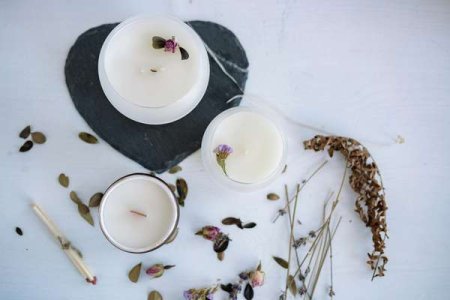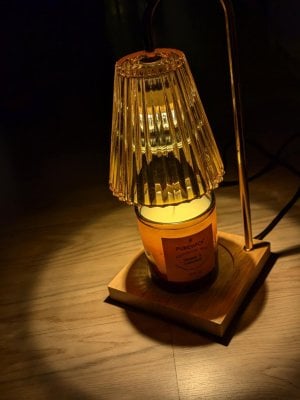The surprising reason why your favourite scented candle could be harming your health
By
Maan
- Replies 14
When it comes to creating the perfect atmosphere at home, many of us turn to the comforting glow and scents of candles.
But could this simple habit be putting our health at risk?
It’s time to take a closer look at what’s really going on when we light that flame. Here’s what you need to know.
Lighting a scented candle might fill your space with the festive aroma of gingerbread, cinnamon, or pine, but it could also pose risks to your health.
A recent study revealed that burning candles significantly impacts indoor air quality, potentially harming your lungs more than passive smoke exposure.
Candles release a mix of chemicals and fine particulate matter as they burn, which includes harmful gases such as carbon monoxide, sulfur dioxide, and nitrogen oxides.
In addition, scented candles and incense sticks emit volatile organic compounds (VOCs), which, when inhaled, can trigger coughing, sneezing, eye irritation, and worsen asthma symptoms.
Dr Asit Kumar Mishra from University College Cork and Dr Marie Coggins from the University of Galway found that long-term exposure may increase the risk of heart disease, chronic bronchitis, and lung cancer.
The research monitored the air quality of 14 homes in Galway, Ireland.
Measurements were taken 24 hours before and after making modifications to improve energy efficiency.
Results showed that burning scented candles could elevate fine particle levels to 15 times higher than World Health Organisation (WHO) safety limits, increasing the risk of lung damage.
The study found that PM2.5, tiny soot particles invisible to the eye, can penetrate deep into the lungs and even enter the bloodstream.
Emitted from vehicle engines, wood-burning stoves, and cigarette smoke, PM2.5 particles have been linked to inflammation in the lungs that can trigger harmful genetic mutations.
The International Agency for Research on Cancer (IARC) classified PM2.5 as a Group 1 carcinogen in 2013 due to its association with lung cancer.
In households that do not smoke, candles may be the primary source of indoor pollution, releasing ultra-fine particles and black carbon.
Notably, a flickering candle flame can generate more particles compared to a steady one. In confined spaces like small bathrooms or bedrooms, the concentration of pollutants can be especially high, presenting a greater health risk.
Poorly ventilated rooms pose additional dangers, as they can accumulate pollutants such as formaldehyde, a colourless, pungent chemical linked to upper airway irritation.
Moreover, scented candles may be more harmful than unscented ones, producing even higher levels of fine particulates.
A significant challenge lies in knowing which chemicals are being released into your home.
Dr Mishra and Dr Coggins pointed out that only about 10 per cent of the ingredients used in candles are disclosed on packaging. This is because manufacturers in the US and EU are not required to list all components.
Nitrogen oxides, which are also produced by vehicles, can damage lung tissue. Certain organic compounds emitted, such as benzene, phthalates, and formaldehyde, have potential carcinogenic properties, according to the American Lung Association.
The immediate effects of exposure include reduced cognitive function, and chronic exposure to incense smoke has been tied to cognitive decline, as highlighted in a 2020 study.
Even candles made with natural ingredients are not necessarily safer; some natural chemicals can react with ozone in the air, creating toxic byproducts.
Experts recommend burning candles in well-ventilated rooms and using them sparingly. Keeping windows open in larger spaces can help mitigate the harmful effects.
However, it’s worth noting that more research is needed to fully understand the health implications.

With all these potential risks, it makes you wonder: is the cosy atmosphere worth the health trade-off? Have you thought about the impact of candles on your indoor air quality? Share your thoughts or experiences in the comments below — we’d love to hear from you!
But could this simple habit be putting our health at risk?
It’s time to take a closer look at what’s really going on when we light that flame. Here’s what you need to know.
Lighting a scented candle might fill your space with the festive aroma of gingerbread, cinnamon, or pine, but it could also pose risks to your health.
A recent study revealed that burning candles significantly impacts indoor air quality, potentially harming your lungs more than passive smoke exposure.
Candles release a mix of chemicals and fine particulate matter as they burn, which includes harmful gases such as carbon monoxide, sulfur dioxide, and nitrogen oxides.
In addition, scented candles and incense sticks emit volatile organic compounds (VOCs), which, when inhaled, can trigger coughing, sneezing, eye irritation, and worsen asthma symptoms.
Dr Asit Kumar Mishra from University College Cork and Dr Marie Coggins from the University of Galway found that long-term exposure may increase the risk of heart disease, chronic bronchitis, and lung cancer.
The research monitored the air quality of 14 homes in Galway, Ireland.
Measurements were taken 24 hours before and after making modifications to improve energy efficiency.
Results showed that burning scented candles could elevate fine particle levels to 15 times higher than World Health Organisation (WHO) safety limits, increasing the risk of lung damage.
The study found that PM2.5, tiny soot particles invisible to the eye, can penetrate deep into the lungs and even enter the bloodstream.
Emitted from vehicle engines, wood-burning stoves, and cigarette smoke, PM2.5 particles have been linked to inflammation in the lungs that can trigger harmful genetic mutations.
The International Agency for Research on Cancer (IARC) classified PM2.5 as a Group 1 carcinogen in 2013 due to its association with lung cancer.
In households that do not smoke, candles may be the primary source of indoor pollution, releasing ultra-fine particles and black carbon.
Notably, a flickering candle flame can generate more particles compared to a steady one. In confined spaces like small bathrooms or bedrooms, the concentration of pollutants can be especially high, presenting a greater health risk.
Poorly ventilated rooms pose additional dangers, as they can accumulate pollutants such as formaldehyde, a colourless, pungent chemical linked to upper airway irritation.
Moreover, scented candles may be more harmful than unscented ones, producing even higher levels of fine particulates.
A significant challenge lies in knowing which chemicals are being released into your home.
Dr Mishra and Dr Coggins pointed out that only about 10 per cent of the ingredients used in candles are disclosed on packaging. This is because manufacturers in the US and EU are not required to list all components.
Nitrogen oxides, which are also produced by vehicles, can damage lung tissue. Certain organic compounds emitted, such as benzene, phthalates, and formaldehyde, have potential carcinogenic properties, according to the American Lung Association.
The immediate effects of exposure include reduced cognitive function, and chronic exposure to incense smoke has been tied to cognitive decline, as highlighted in a 2020 study.
Even candles made with natural ingredients are not necessarily safer; some natural chemicals can react with ozone in the air, creating toxic byproducts.
Experts recommend burning candles in well-ventilated rooms and using them sparingly. Keeping windows open in larger spaces can help mitigate the harmful effects.
However, it’s worth noting that more research is needed to fully understand the health implications.
Key Takeaways
- Burning scented candles can release harmful chemicals and fine particles that affect indoor air quality and health.
- Long-term exposure to these pollutants may increase the risk of heart disease, chronic bronchitis, and lung cancer.
- Nitrogen oxides and organic compounds like benzene, phthalates, and formaldehyde are among the harmful substances emitted.
- Even candles made with natural ingredients can produce toxic byproducts when they react with ozone in the air.
With all these potential risks, it makes you wonder: is the cosy atmosphere worth the health trade-off? Have you thought about the impact of candles on your indoor air quality? Share your thoughts or experiences in the comments below — we’d love to hear from you!











